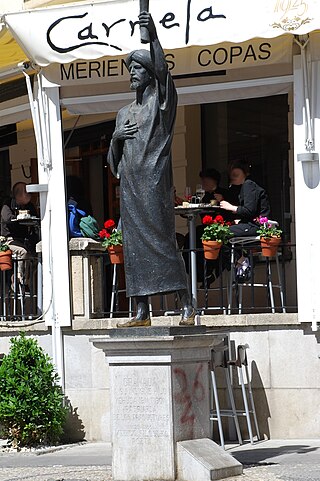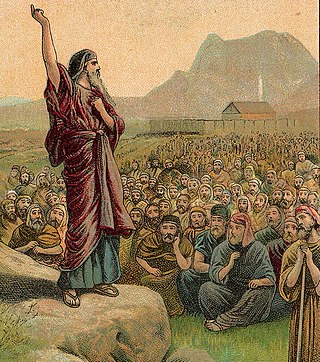
Rabbinic literature, in its broadest sense, is the entire spectrum of rabbinic writings throughout Jewish history. However, the term often refers specifically to literature from the Talmudic era, as opposed to medieval and modern rabbinic writings, and thus corresponds with the Hebrew term Sifrut Chazal. This more specific sense of "Rabbinic literature"—referring to the Talmudim, Midrashim, and related writings, but hardly ever to later texts—is how the term is generally intended when used in contemporary academic writing. The terms mefareshim and parshanim (commentaries/commentators) almost always refer to later, post-Talmudic writers of rabbinic glosses on Biblical and Talmudic texts.
The golden age of Jewish culture in Spain, which coincided with the Middle Ages in Europe, was a period of Muslim rule during which, intermittently, Jews were generally accepted in society and Jewish religious, cultural, and economic life flourished.

Judeo-Arabic dialects are ethnolects formerly spoken by Jews throughout the Arab world. Under the ISO 639 international standard for language codes, Judeo-Arabic is classified as a macrolanguage under the code jrb, encompassing four languages: Judeo-Moroccan Arabic (aju), Judeo-Yemeni Arabic (jye), Judeo-Iraqi Arabic (yhd), and Judeo-Tripolitanian Arabic (yud).
Chovot HaLevavot, or Ḥobot HaLebabot, is the primary work of the Jewish rabbi, Bahya ibn Paquda, full name Bahya ben Joseph ibn Pakuda. Rabbi Ibn Paquda is believed to have lived in Zaragoza, Al-Andalus in the eleventh century.
Rishonim were the leading rabbis and poskim who lived approximately during the 11th to 15th centuries, in the era before the writing of the Shulchan Aruch and following the Geonim. Rabbinic scholars subsequent to the Shulchan Aruch are generally known as acharonim.
Gilgul is a concept of reincarnation or "transmigration of souls" in Kabbalistic esoteric mysticism. In Hebrew, the word gilgul means "cycle" or "wheel" and neshamot is the plural for "souls." Souls are seen to cycle through lives or incarnations, being attached to different human bodies over time. Which body they associate with depends on their particular task in the physical world, spiritual levels of the bodies of predecessors and so on. The concept relates to the wider processes of history in Kabbalah, involving cosmic Tikkun, and the historical dynamic of ascending Lights and descending Vessels from generation to generation.
Abraham ben David, also known by the abbreviation RABaDRavad or RABaD III, was a Provençal rabbi, an important commentator on the Talmud, Sefer Halachot of Rabbi Yitzhak Alfasi and Mishne Torah of Maimonides, and is regarded as a father of Kabbalah and one of the key links in the chain of Jewish mystics.

Bahya ben Asher ibn Halawa was a rabbi and scholar of Judaism, best known as a commentator on the Hebrew Bible. He is one of two scholars now referred to as Rabbeinu Behaye, the other being philosopher Bahya ibn Paquda.

Judah ben Saul ibn Tibbon was a translator and physician.

Hebrew literature consists of ancient, medieval, and modern writings in the Hebrew language. It is one of the primary forms of Jewish literature, though there have been cases of literature written in Hebrew by non-Jews. Hebrew literature was produced in many different parts of the world throughout the medieval and modern eras, while contemporary Hebrew literature is largely Israeli literature. In 1966, Agnon won the Nobel Prize for Literature for novels and short stories that employ a unique blend of biblical, Talmudic and modern Hebrew, making him the first Hebrew writer to receive this award.
Rabbi Zerachiah the Greek was a Greek-Jewish ethicist who resided in the Byzantine Empire in the thirteenth or fourteenth century. Of his life no details are known, except that he was the author of an ethical work entitled Sefer ha-Yashar ; this work was confused with Jacob Tam's halakhic work of the same name and erroneously attributed to the renowned tosafist. This error was detected by Menahem Lonzano, who, in his poem "Derek Ḥayyim", expressly states that the ethical work in question belonged to Zerahiah. Lonzano did not succeed, however, in correctly establishing the identity of its author, for a second error immediately arose. Since Zerahiah ha-Yewani had the same initials as Zerachiah Ha-Levi Gerondi, the author of the well-known Sefer ha-Ma'or, the Sefer ha-Yashar was attributed by some bibliographers to the latter.
Meshullam son of Jacob also known as Rabbeinu Meshullam hagodol was a Franco-Jewish Talmudist of the twelfth century CE. He led a Talmudic Yeshiva in Lunel which produced several famous scholars, and was an intimate friend of Abraham ben Isaac, Av beth din of Narbonne, who addressed to him several responsa, and spoke of him in high terms. His Talmudic decisions are quoted in Sefer ha-Terumot.

Va'etchanan is the 45th weekly Torah portion in the annual Jewish cycle of Torah reading and the second in the Book of Deuteronomy. It comprises Deuteronomy 3:23–7:11. The parashah tells how Moses asked to see the Land of Israel, made arguments to obey the law, recounted setting up the Cities of Refuge, recited the Ten Commandments and the Shema, and gave instructions for the Israelites' conquest of the Land. The parashah is made up of 7,343 Hebrew letters, 1,878 Hebrew words, 122 verses, and 249 lines in a Torah Scroll. Jews in the Diaspora generally read it in late July or August.

Nitzavim, Nitsavim, Nitzabim, Netzavim, Nisavim, or Nesabim is the 51st weekly Torah portion in the annual Jewish cycle of Torah reading and the eighth in the Book of Deuteronomy. It comprises Deuteronomy 29:9–30:20. In the parashah, Moses told the Israelites that all the people stood before God to enter into the covenant, violation of which would bring on curses, but if they returned to God and heeded God's commandments, then God would take them back in love and bring them together again from the ends of the world. Moses taught that this Instruction was not beyond reach, and Moses put before the Israelites life and death, blessing and curse, and exhorted them to choose life by loving God and heeding the commandments.
Haazinu, Ha'azinu, or Ha'Azinu is the 53rd weekly Torah portion in the annual Jewish cycle of Torah reading and the 10th in the Book of Deuteronomy. It constitutes Deuteronomy 32:1–52. The parashah sets out the Song of Moses—an indictment of the Israelites' sins, a prophecy of their punishment, and a promise of God's ultimate redemption of them.

Rabbi Joseph ben Jacob ibn Tzaddik was a Spanish rabbi, poet, and philosopher. A Talmudist of high repute, he was appointed in 1138 dayyan at Cordova, which office he held conjointly with Maimon, father of Maimonides, until his death. Joseph was also a highly gifted poet, as is attested by Alharizi. Several of Joseph's religious poems are found in the Sephardic and African machzorim; and a poem addressed to Judah ha-Levi, on his visit to Cordova en route to Palestine, is included in the latter's diwan.
Very few texts in Judaism refer to or take note of the Islamic prophet, Muhammad. Those that do generally reject Muhammad's proclamation of receiving divine revelations from God and label him instead as a false prophet.
Kavanah, kavvanah or kavana, plural kavanot or kavanos (Ashkenazim), literally means "intention" or "sincere feeling, direction of the heart". It is the mindset often described as necessary for Jewish rituals (mitzvot) and prayers. Kavanah is a theological concept in Judaism about a worshiper's state of mind and heart, his or her sincerity, devotion and emotional absorption during prayers.

Natan'el al-Fayyumi, born about 1090 – died about 1165, of Yemen was the twelfth-century author of Bustan al-Uqul, a Jewish version of Ismaili Shi'i doctrines, and a complete imitation of Bahya ibn Paquda's book, Duties of the Heart, and which Al-Fayyumi composed, in his own words, to counter some of the basic principles and tenets of Judaism expressed by Ibn Paquda, writing in his 3rd chapter that God's unity is far greater than that described by Ibn Paquda. Like the Ismailis, Natan'el argued that God sent different prophets to the various nations of the world, containing legislations suited to the particular temperament of each individual nation. Each people should remain loyal to its own religion, because the universal teaching was adapted to the specific conditions and experiences of each community. Not all Jewish depictions of Muhammad were negative. Jews who lived in environments governed by Ismailis did not view them as enemies, and vice versa.
Musar literature is didactic Jewish ethical literature which describes virtues and vices and the path towards character improvement. This literature gives the name to the Musar movement, in 19th century Lithuania, but this article considers such literature more broadly.








